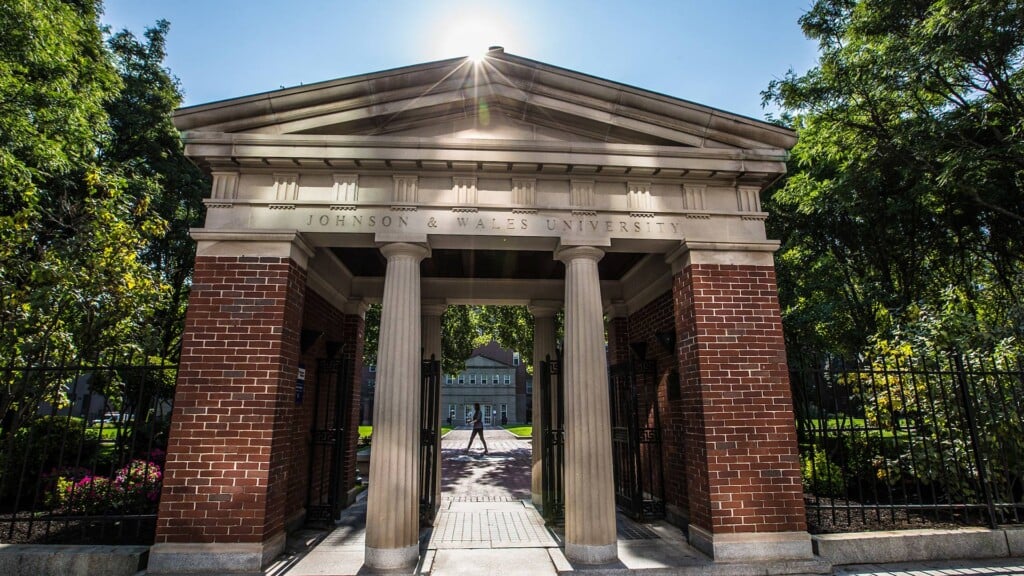Prowling for Owls with the Audubon Society of Rhode Island
The organization launched a new effort to survey nocturnal species on its properties. We tagged along to see how it’s done.

This barred owl was spotted at the Audubon Fort Wildlife Refuge in North Smithfield. (Photo by Jason Major)
It’s nearing 7 p.m. when I pull into the parking lot of the George B. Parker Woodland Wildlife Refuge in Coventry, and the birds are beginning their dusk chorus. I grab my backpack and take a quick inventory of my reporting equipment: notebook, check. Pen, check. Bug spray, check.
It’s not often my stories send me out hiking with strangers after dark, but this is not a typical assignment. Earlier this month, the Audubon Society of Rhode Island launched a new effort to survey nocturnal bird species on all fourteen of its properties across the state. The survey, the first of its kind in Rhode Island, involves close to fifty volunteers visiting Audubon refuges to listen for owls, nightjars and other species over an eight-night window. These species are often underrepresented in traditional bird surveys that usually take place during the day.
Heading up the effort is Charles Clarkson, the organization’s new director of avian research. The ASRI created the position last fall to direct efforts to assess the state’s bird populations. Though it’s a fresh title, Clarkson is far from a new face when it comes to studying Rhode Island’s birds. He’s been a part of the local scientific community for the past ten years and held positions at the University of Rhode Island, Salve Regina University and Roger Williams University. His last role involved overseeing the Rhode Island Bird Atlas, a five-year effort to survey the state’s entire bird population that spanned from 2015 to 2020.
In his new role, Clarkson is responsible for developing programs to protect and manage birds on Audubon’s refuge properties in Rhode Island. That’s what brings us here tonight — seeking out one of the Ocean State’s most secretive nighttime critters.
“With all of the issues being faced by bird populations from climate change and habitat loss, the idea was that we really need to start gathering data on the bird populations across the Audubon refuge complex,” Clarkson explains as we gather our things in the parking lot. “We manage 9,600, give or take, acres of land.”
To protect Rhode Island’s birds, Clarkson first needs to know which birds are hanging out on Audubon properties and at what times of year. Bird surveys have traditionally focused on breeding season, but Clarkson says that data does not always paint the most accurate picture, especially as deforestation and climate change disrupt some of birds’ habits. Birds that enjoy protected properties here might migrate seasonally from somewhere DDT still wreaks havoc on their reproductive cycles. His project attempts to detect birds across the full range of conditions in which they live in Rhode Island, including a winter survey (already completed) and our current effort to listen for birds at night.
“Owls are always kind of missed in these big survey projects, and we certainly wanted to avoid missing them for our survey,” he says. “The beauty about having these preserved tracts of land that have established hiking trails is you can pretty safely survey nocturnal species.”
Joining us on our owl survey are Linda Gardrel, a volunteer from Wakefield, and Clarkson’s thirteen-year-old daughter, Duduzile. Gardrel first met Clarkson at a bird banding station in Beavertail before joining him on several of the bird watching trips he leads internationally. An avid birder, she discovered the hobby after moving to the state from New Hampshire in 1996.
“I got hooked, and I did it every week on Tuesday from 8 to 11,” she says. “It was spectacular to go in the woods, open your eyes and ears, and there’s a whole new world out there.”
Owls, as I learn while preparing for our survey walk, are very particular about when they’ll make their distinctive nighttime calls. They enjoy clear, moonlit nights, so the eight-night window around the full moon is key. Dusk and the hours just after are the best time to hear these birds, and they vocalize more often during the breeding season in late winter and spring.
Unfortunately, due to various scheduling conflicts, we follow very few of our own recommendations. As I pull up to Parker Woodland, clouds obscure what should be a colorful April sunset into a gray blur. Pulling out his data sheet, Clarkson checks off the weather condition that reads “dense cloud cover.” Next to that, in bold, capital letters are the words “DO NOT CONDUCT SURVEY.” We set out anyway, determined to search for owls in our narrow, eight-night window.
He tells us to keep our eyes peeled for birds that might swoop through the twilit branches. Our mission is mostly a listening one, as the birds themselves use noise to communicate with rivals or potential mates. The most common owl species in Rhode Island are the great horned, barred and Eastern screech, each with their own distinct calls. We might also hear the Eastern whip-poor-will, a type of nightjar whose song once rang out frequently across summer nights in New England.
As we head down the trail into the woods, a chorus of spring peepers chants noisily from a nearby brook. A near-full moon hangs low on the horizon despite the clouds, giving me hope we might hear more than frogs tonight. A twittering bird flies across the trees in front of us. Without breaking step, Clarkson identifies it as a Louisiana waterthrush.
“Great bird. Just showed up, no doubt, from a long migration,” he says.
Stepping carefully over roots, I remind myself I’m supposed to be looking for owls in the trees. Ahead of me, Duduzile skips along from rock to rock with the lightness of someone who’s done this many times before. I’m realizing my plan to take notes as we walk was a terrible idea.
I begin to hear other bird sounds as we walk deeper into the woods. Then, far in the distance, we hear a rumble of what might be thunder. Clarkson pulls out his phone. Sure enough, the radar shows a storm headed our way over Connecticut. We press on a short while longer, still hoping to hear just one of our quarry before rain envelops the refuge.
Earlier, as we collected ourselves in a field near the parking lot, Clarkson had explained what’s at stake. Over the past ten years, reports have shown a precipitous decline in the majority of bird populations in North America. For some species, ornithologists are predicting outright extinction if nothing changes with regard to climate change or habitat loss.
“It’s a very perilous time to be a bird,” he says. “Populations are declining rapidly. Birds are maxed out from a physiological standpoint pretty much all the time. They’ve evolved over 160 million years to walk that fine line between life and death all day long because their physiology is so high. They have the highest resting metabolism of any vertebrate.”
If we do nothing but continue the status quo, he says, it won’t be long before we lose many species of birds. From a conservation perspective, he adds, it’s important to not only put targeted management plans in place but have a baseline understanding of the population to see how things change over time. To this end, forty-five volunteers have signed up to survey owls across Audubon’s properties during the eight-night window. Hopefully, most of them have picked a better weather night than we did.
After about twenty-five minutes, we pause near a stream to listen. There’s nothing to be heard but the tinkling of water and, even here on the refuge, the sound of distant traffic.
As the rain begins to fall, we turn back, ready to admit defeat on our owl search. Our slow, careful walk turns into a race for the car as the weather picks up. Even at this pace, Clarkson displays the sharp eyes and hypersensitivity to nature of an ornithologist. Halfway back to the parking lot, he stops suddenly and shines his flashlight straight down at the trail, where a large, fuzzy, black caterpillar is crossing the path.
The rain is coming down hard as we reach the field. As we head for the car, Clarkson pulls up short once again and shines his flashlight off to the right, where three or four deer stand staring back at us through the shower. A short distance later, he stops again, this time to swing the flashlight beam around to a mouse making its way through the grass. I marvel at his eyesight and ability to detect things trying very hard to be invisible at night.
“This would be a great time for an owl to swoop in,” he says, adding that he looks at the animals around us as a food web, much like the predators we’re searching for.
By the time we reach the parking lot, it’s clear I won’t be hearing any owls on my first nocturnal bird survey. Somehow, it doesn’t feel like a complete failure. I’ve seen a host of other nighttime creatures and viewed the ecosystem around us through the eyes of an ornithologist who knows more about it than most bird watchers will learn in a lifetime. Clarkson tells me that even for trained volunteers, the owls can be capricious. On a single night, one group might hear several nocturnal hoots and another might hear nothing at the same refuge. I chalk my own lack of success up to nature’s unpredictability and figure there will always be time to search in the future with my newfound owl knowledge.
Several days later, Clarkson sends me the preliminary results submitted by volunteers. They’ve identified twenty-seven owls of three different species across Audubon’s fourteen properties, along with one nightjar and three American woodcocks. These numbers are the beginnings of a plan that will help preserve these creatures in Rhode Island for years to come.
A week-and-a-half after our unsuccessful attempt, I’m walking through my neighborhood in the evening when I hear a sound from some nearby trees. It’s not a hoot in the traditional sense, or any sound I normally associate with birds. Instead, it’s a low, soft, ringing trill that reminds me vaguely of the noise a car might make on the highway when something is stuck in the wheel well. I pull out my phone and start recording. I tell myself it’s probably a frog or another critter, but as I retrace my steps back home, I’m hopeful the elusive owl might have finally revealed itself.
The next morning, Clarkson confirms my find. The recording belongs to an Eastern screech-owl, a small bird about eight inches high whose calls range from a loud screech to a whinnying neigh to my faulty hubcap noise. It’s common in suburban areas, but I’m still amazed after walking the refuge to discover this Rhode Islander so close to my front door. I’m reminded of the reasons behind the survey and the importance of conserving space for this little resident to thrive. We are neighbors, after all (literally, in my case), and in a state as small as ours, sometimes that means making space for each other.
RELATED ARTICLES
Birds of Prey are Making a Comeback in Rhode Island
It’s Been a Wild Year at Roger Williams Park Zoo
Get to Know the Adorable Oxen at Blackbird Farm





























